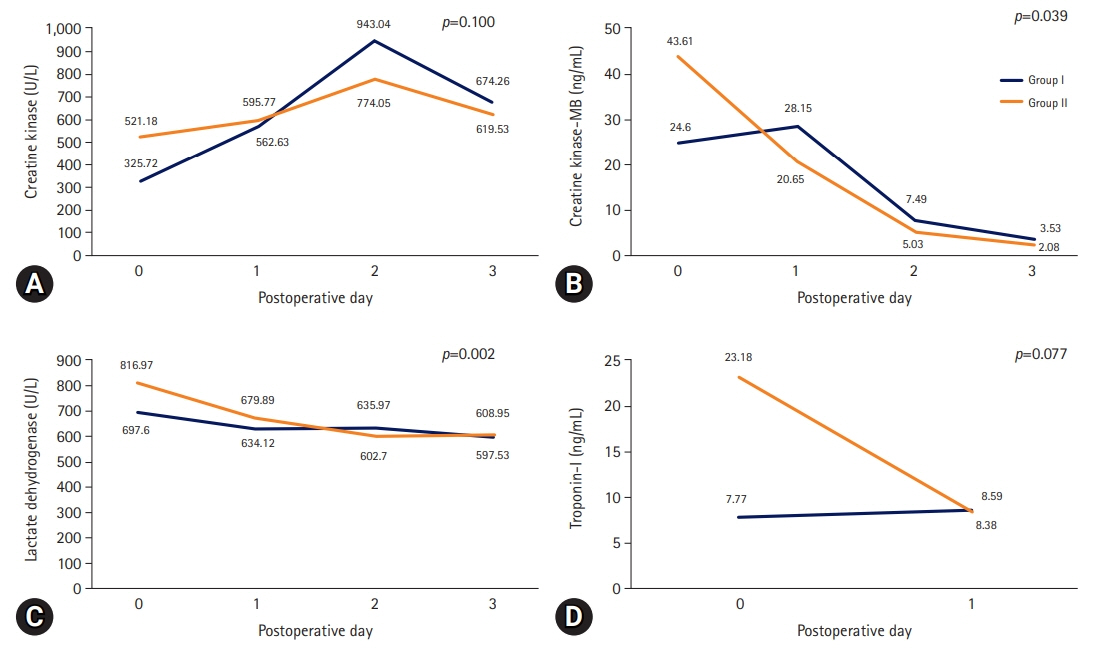J Yeungnam Med Sci.
2023 Nov;40(Suppl):S23-S28. 10.12701/jyms.2023.00283.
Surgical results of only antegrade del Nido cardioplegia infusion in conventional coronary artery bypass grafting: a retrospective study
- Affiliations
-
- 1Department of Thoracic and Cardiovascular Surgery, Keimyung University School of Medicine, Daegu, Korea
- KMID: 2548339
- DOI: http://doi.org/10.12701/jyms.2023.00283
Abstract
- Background
Additional retrograde cardioplegia infusion in conventional coronary artery bypass grafting (CABG) was introduced to address the concern of inappropriate cardioplegia delivery through the stenotic coronary artery. However, this method is complex and requires repeated infusions. Therefore, we investigated the surgical outcomes of only antegrade cardioplegia infusion in conventional CABG.
Methods
We included 224 patients who underwent isolated CABG between 2017 and 2019. The patients were divided into two groups according to the cardioplegia infusion method: antegrade cardioplegia infusion with del Nido solution (n=111, group I) and antegrade+retrograde cardioplegia infusion with blood cardioplegia solution (n=113, group II).
Results
The sinus recovery time after release of the aorta cross-clamp was shorter in group I (3.8±7.1 minutes, n=98) than in group II (5.8±4.1 minutes, n=73) (p=0.033). The total cardioplegia infusion volume was lower in group I (1,998.6±668.6 mL) than in group II (7,321.0±2,865.3 mL) (p<0.001). Creatine kinase-MB levels were significantly lower in group I than in group II (p=0.039). Newly developed regional wall motion abnormalities on follow-up echocardiography were detected in two patients (1.8%) in group I and five patients (4.4%) in group II (p=0.233). There was no significant difference in ejection fraction improvement between the two groups (3.3%±9.3% in group I and 3.3%±8.7% in group II, p=0.990).
Conclusion
The only antegrade cardioplegia infusion strategy in conventional CABG is safe and has no harmful effects.
Figure
Reference
-
References
1. Guru V, Omura J, Alghamdi AA, Weisel R, Fremes SE. Is blood superior to crystalloid cardioplegia?: a meta-analysis of randomized clinical trials. Circulation. 2006; 114(1 Suppl):I331–8.2. Flack JE 3rd, Cook JR, May SJ, Lemeshow S, Engelman RM, Rousou JA, et al. Does cardioplegia type affect outcome and survival in patients with advanced left ventricular dysfunction?: results from the CABG Patch Trial. Circulation. 2000; 102(19 Suppl 3):III84–9.3. Matte GS, del Nido PJ. History and use of del Nido cardioplegia solution at Boston Children’s Hospital. J Extra Corpor Technol. 2012; 44:98–103.
Article4. O’Brien JD, Howlett SE, Burton HJ, O’Blenes SB, Litz DS, Friesen CL. Pediatric cardioplegia strategy results in enhanced calcium metabolism and lower serum troponin T. Ann Thorac Surg. 2009; 87:1517–23.
Article5. Govindapillai A, Hua R, Rose R, Friesen CH, O’Blenes SB. Protecting the aged heart during cardiac surgery: use of del Nido cardioplegia provides superior functional recovery in isolated hearts. J Thorac Cardiovasc Surg. 2013; 146:940–8.
Article6. Newton DJ, McLeod GA, Khan F, Belch JJ. Mechanisms influencing the vasoactive effects of lidocaine in human skin. Anaesthesia. 2007; 62:146–50.
Article7. Heydarpour M, Ejiofor J, Gilfeather M, Stone G, Gorham J, Seidman CE, et al. Molecular genetics of lidocaine-containing cardioplegia in the human heart during cardiac surgery. Ann Thorac Surg. 2018; 106:1379–87.
Article8. Perrelli MG, Pagliaro P, Penna C. Ischemia/reperfusion injury and cardioprotective mechanisms: role of mitochondria and reactive oxygen species. World J Cardiol. 2011; 3:186–200.
Article9. Charette K, Gerrah R, Quaegebeur J, Chen J, Riley D, Mongero L, et al. Single dose myocardial protection technique utilizing del Nido cardioplegia solution during congenital heart surgery procedures. Perfusion. 2012; 27:98–103.
Article10. Ad N. del Nido cardioplegia: ready for prime time in adult cardiac surgery? J Thorac Cardiovasc Surg. 2015; 149:637–8.11. Ad N, Holmes SD, Massimiano PS, Rongione AJ, Fornaresio LM, Fitzgerald D. The use of del Nido cardioplegia in adult cardiac surgery: a prospective randomized trial. J Thorac Cardiovasc Surg. 2018; 155:1011–8.
Article12. Ramanathan R, Parrish DW, Armour TK, Brinster DR. Use of del Nido cardioplegia in adult cardiac surgery. Thorac Cardiovasc Surg. 2015; 63:624–7.
Article13. Guajardo Salinas GE, Nutt R, Rodriguez-Araujo G. Del Nido cardioplegia in low risk adults undergoing first time coronary artery bypass surgery. Perfusion. 2017; 32:68–73.
Article14. Yerebakan H, Sorabella RA, Najjar M, Castillero E, Mongero L, Beck J, et al. Del Nido cardioplegia can be safely administered in high-risk coronary artery bypass grafting surgery after acute myocardial infarction: a propensity matched comparison. J Cardiothorac Surg. 2014; 9:141.
Article15. Timek T, Willekes C, Hulme O, Himelhoch B, Nadeau D, Borgman A, et al. Propensity matched analysis of del Nido cardioplegia in adult coronary artery bypass grafting: initial experience with 100 consecutive patients. Ann Thorac Surg. 2016; 101:2237–41.
Article16. Timek TA, Beute T, Robinson JA, Zalizadeh D, Mater R, Parker JL, et al. Del Nido cardioplegia in isolated adult coronary artery bypass surgery. J Thorac Cardiovasc Surg. 2020; 160:1479–85.
Article
- Full Text Links
- Actions
-
Cited
- CITED
-
- Close
- Share
- Similar articles
-
- Open-heart surgery using Del-Nido cardioplegia in two dogs: partial atrioventricular septal defect and mitral repair
- Off-Pump Coronary Artery Bypass Grafting in Moyamoya Disease
- "Off-Pump" Coronary rtery bypass Grafting in Multi-vessel Coronary Disease: Two Cases
- Surgical result of coronary artery bypass grafting-The effect of Pre and intraoperative procedures
- The Effect of Simultaneous and Alternative Cardioplegia Delivery on Right Ventricular Preservation in Patients Undergoing Right Coronary Artery Bypass Graft Surgery


